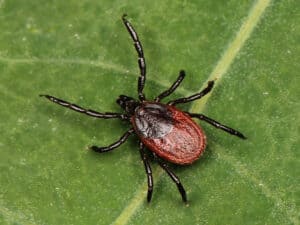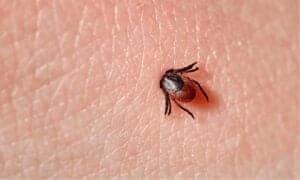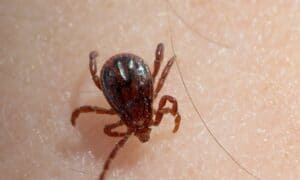The Complete Guide To All Types Of Ticks
@media (min-width: 481px) {
.mobile-top-content {
display: none;
}
}
#mobileTopContentCTACarouselControls { overflow: hidden; text-overflow: ellipsis; white-space: nowrap; }
.mobile-top-content .more { color: #fff; }
.mobile-top-content a { color: #fff; text-decoration: underline; }
.mobile-top-content a:hover { color: #fff; text-decoration: underline; }
@media (max-width: 480px) {
.mobile-top-content {
background-color: #06a10b;
color: #fff;
text-align: center;
/*height: 60px;
padding-top:5px;*/
font-size:80%;
/* display: block; */
margin: 0px -30px;
}
}
The only thing worse than the idea of a tick is just how many species of them exist. Believe it or not, there are nine hundred known species of ticks found worldwide, and knowing this is enough to give anyone nightmares. But we absolutely must know how to identify them. While most ticks do not cause lasting harm, some of these parasitic bloodsuckers are vectors for deadly illnesses. While this guide cannot identify every single tick species individually, we can provide you with a comprehensive guide to identifying the two families that tick species fall under and a guide to identifying the most common ticks found in North America.
Additionally, this guide includes links to articles detailing the most common tick species found in each state of the U.S., as well as resources for how to deal with most tick-related issues!
Tick Types: Hard Ticks And Soft Ticks
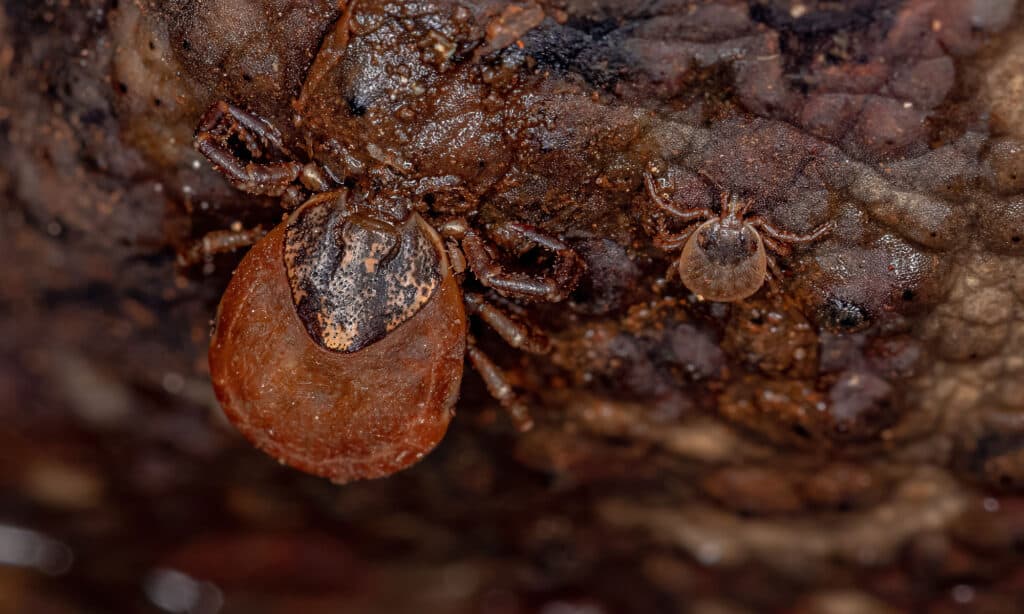
iStock.com/ViniSouza128
All species of ticks are in the class of arachnids, identified by their eight legs in the same way as spiders and scorpions are. In total, there are nine hundred known species of ticks worldwide, and all are parasites that require blood to live. The tick genus is split into two families that each species falls into. These types are referred to as hard (Ixodidae) and soft (Argasidae) ticks. While identifying individual species can be difficult, knowing the difference between hard and soft tick species is easy.
Identifying A Hard Tick Species
There are seven hundred species classified as hard ticks, and they make up the bulk of known tick species. Hard ticks are identified by the hard, shield-like plate located behind the head called the scutum. Hard ticks also have visible mouthparts when viewed from above.
In most species the scutum is black. However, some hard tick species may have different scutum colors depending on whether the tick is male or female. For example, the female Lone Star tick has the signature white dot on the scutum, whereas the male does not. Males and females often have different colorations on the body as well. Additionally, female hard ticks are larger on average than males.
Diet, Life Cycle, And Habitat Of Hard Ticks
Hard ticks are most active during the day to search for a host in locations where larger vertebrate animals are present. They prefer moist wooded areas and grassy fields and are commonly found in overgrown brush or tall grass. Hard ticks have a 2-4 stage life cycle and live between 2-4 years, reproducing once in a life cycle.
Common Examples Of A Hard Tick Species
Common types of hard tick species in the U.S. are the wood tick, the deer tick, the American dog tick, and the lone star tick. Hard ticks are also the type most likely to encounter humans, as their preferred habitat is in open environments. Many of the tick species associated with dangerous illnesses are hard ticks, such as Lyme Disease and Rocky Mountain Spotted Fever. However, hard ticks are also easier to identify by species, which makes it easier to detect illnesses sooner.
Identifying A Soft Tick Species
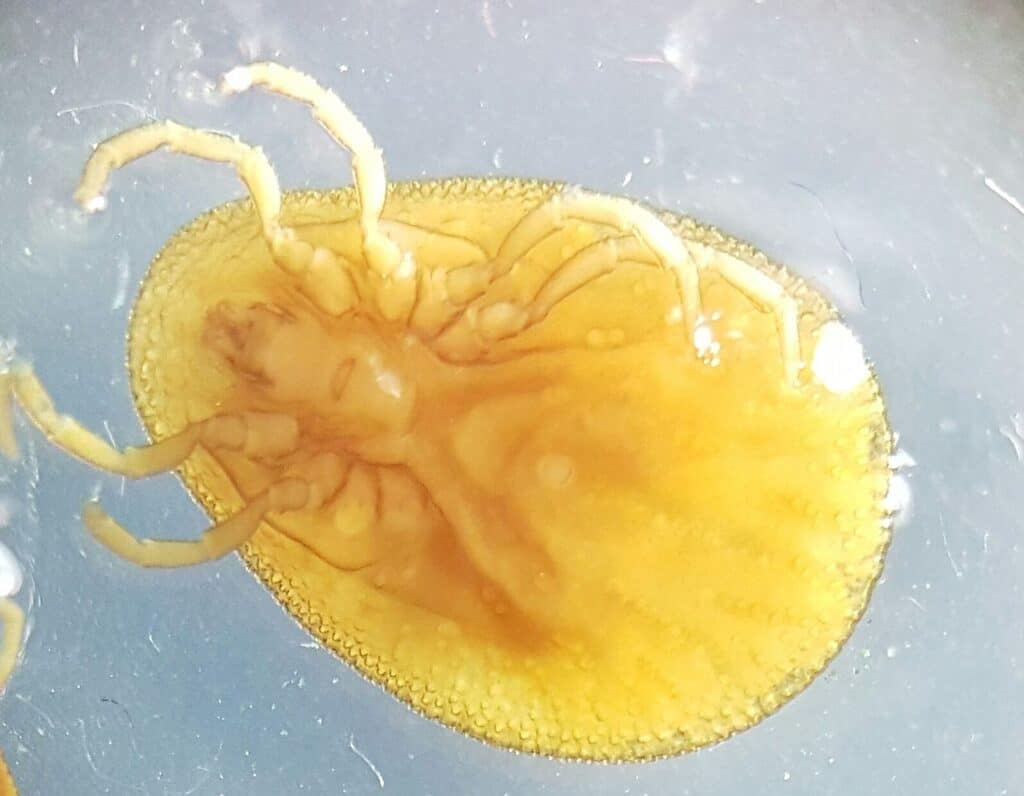
Navid.drogba / Creative Commons – License
There are two hundred known species of soft ticks worldwide. While this is significantly less than the hard tick, it is still a high number. Soft ticks can be identified by their lack of a scutum and their wrinkled and rounder bodies. Additionally, soft ticks do not have visible mouthparts from above, as they are located on the underside of the ticks head. Female and male soft ticks are the same size and do not differ in coloration.
Diet, Life Cycle, And Habitat Of Soft Ticks
Soft ticks are active at night, seeking a host in the dens and burrows of animals, caves, or simple human dwellings in disrepair. Unlike hard ticks, soft ticks feed quickly and move on from a host. These types of ticks also thrive in hot and dry locations like the desert where hard ticks are less common.
Soft ticks go through multiple life cycles, including species that go through many nymph stages. Female soft ticks feed and produce eggs several times during their adult life cycle, producing between 20-40 at a time depending on feeding. Soft ticks can live for up to 16 years regardless of sex.
Soft Ticks And Disease
Humans encounter soft tick species due to rodent infestations in human dwellings. Since soft ticks are nocturnal feeders, bites occur most often while the host is sleeping. Also, as most human contact with tick species occurs with hard ticks, soft ticks are often mistaken for insects. Like hard ticks, most species are harmless apart from the bite, but some are not. Soft ticks are also dangerous because of their short feeding period. Soft ticks only feed for between 15 minutes to an hour and often the host has no idea they have been bitten. The most common illness caused by soft ticks is Tick-Borne Relapsing Fever or TBRF.
Common Examples Of Soft Ticks
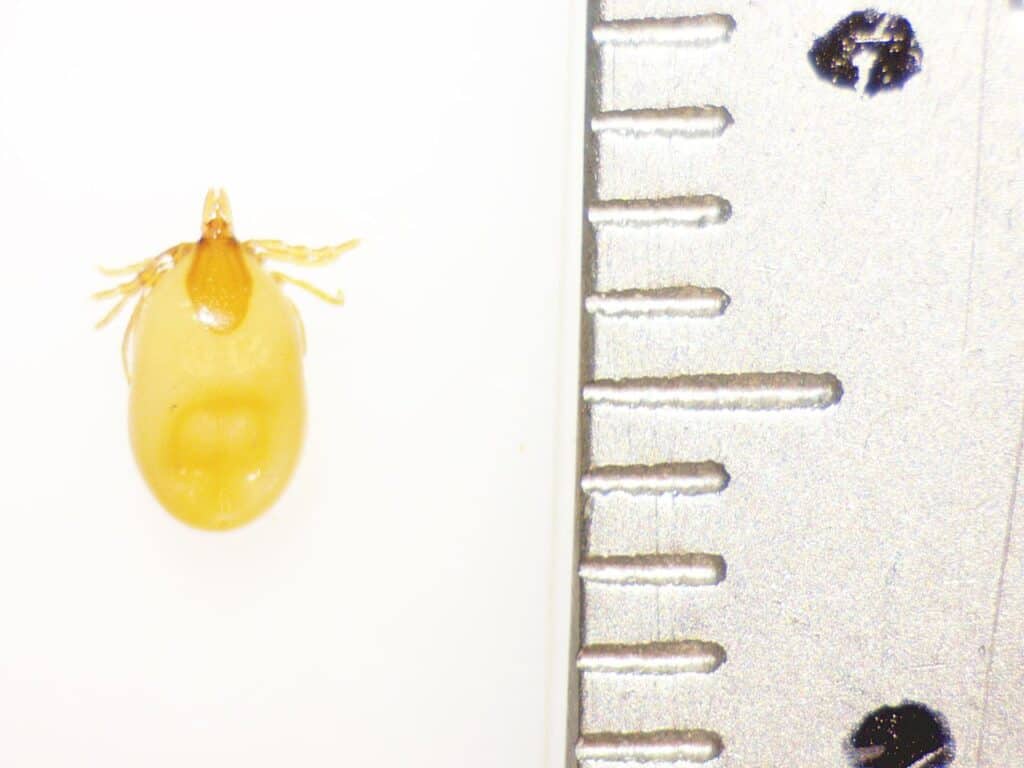
Kellisfm / Creative Commons – License
The most common soft ticks that humans encounter in the United States are common fowl ticks and relapsing fever ticks. As the name suggests, the common fowl tick is found in poultry houses. Also referred to as the chicken tick or the blue bug, these ticks can spread illness to both poultry and humans.
The relapsing fever tick is as dangerous as the deer tick, though they are less likely to choose a human host. Fever ticks prefer small rodents but have been known to infect humans. They get their name from their ability to transmit relapsing fever, a potentially deadly disease. Fever ticks are infected for their entire lives and can transmit the disease multiple times.
A Complete Guide To The Most Common Types Of Ticks
Listing each of the nine hundred known species of ticks in the world would be impossible. However, knowing the difference between a hard tick and a soft tick goes a long way. However, while most species of ticks do not carry diseases to humans, some species are quite dangerous. The most common species of ticks we encounter are the most likely to make us ill, so identification is key. Therefore, this is the complete guide to the most found ticks in the United States.
Dog Tick
The most common type of tick most humans encounter is the dog tick. There are two species, the American and the brown dog tick. Their common name refers to their fondness for choosing mammals like domesticated dogs as a host. However, dog ticks will attach to most small or midsized animals and even relocate to a human if the opportunity is there. Dog ticks are classified as hard ticks, and their appearance varies depending on the species. While American dog ticks are slightly larger than brown dog ticks, when engorged they are identical.
American Dog Tick
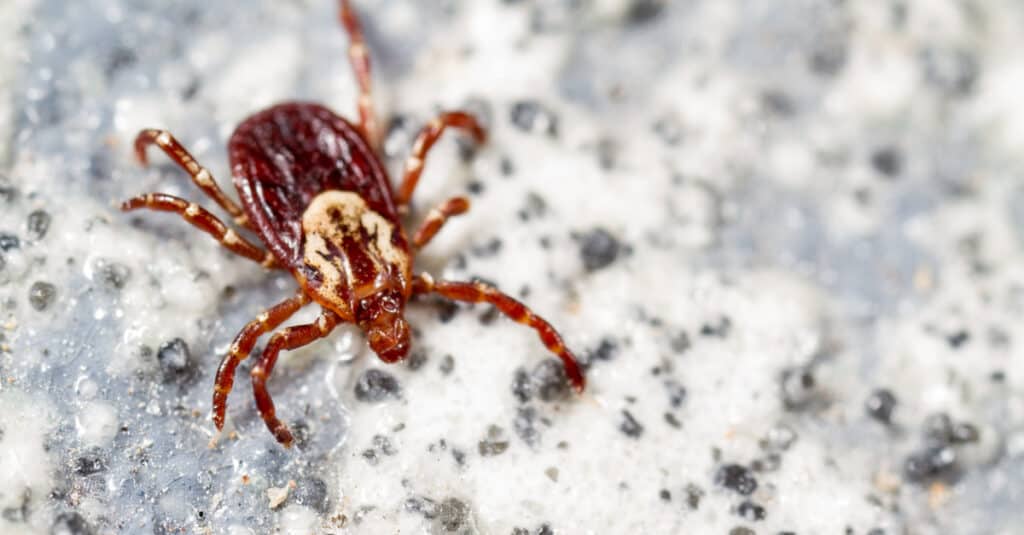
Elliotte Rusty Harold/Shutterstock.com
The American dog tick has a rounded abdomen and is a reddish-brown color with beige markings. On the female tick, the scutum is the only location with these beige markings. In the nymph stage, these ticks have the same markings and look like a paler version of their adult form. American dog ticks prefer to live their lives outdoors to breed. The American dog tick is also known to transmit Rocky Mountain Spotted Fever.
Brown Dog Tick
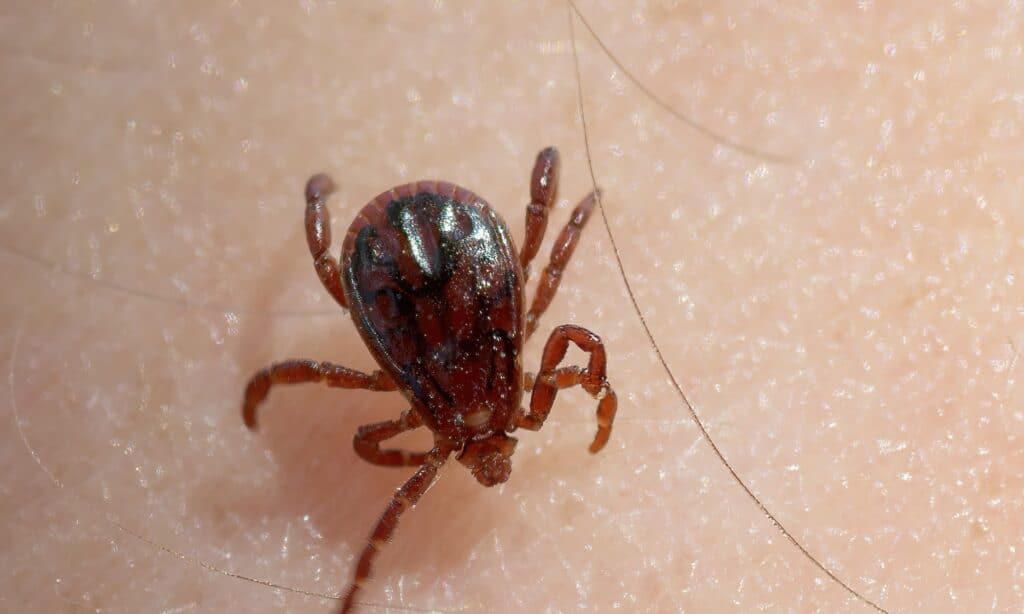
iStock.com/RobertAx
Brown dog ticks have a narrow, oval body that is a medium brown color overall. Both males and females are the same brown color, and nymphs are paler brown. Unlike the American dog tick, the brown dog tick can live its entire life cycle indoors, burrowing into carpets and the fur of house pets. Unlike many other ticks, brown ticks may feed on the same host for different life stages. Brown dog ticks rarely move to a human, preferring dogs to any other host. Check out the article linked here for more on the Brown dog tick.
Deer Tick
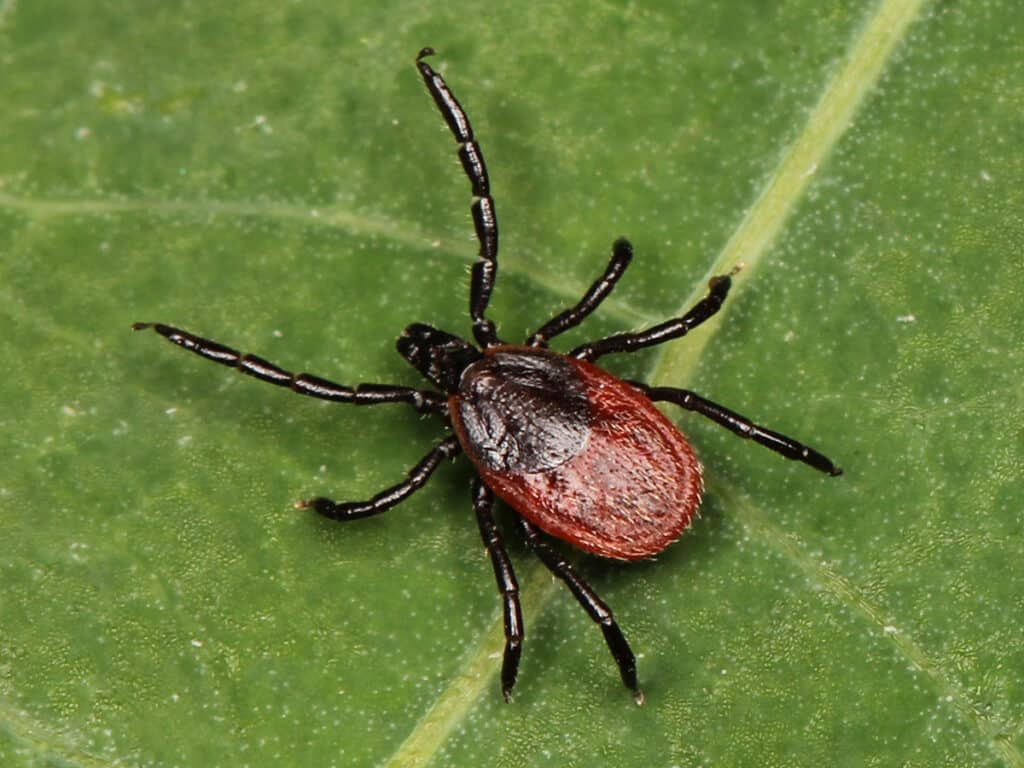
Kaldari / Creative Commons – License
Deer ticks are one of the smaller hard tick species, the size of a sesame seed at the adult life stage. This species has four life cycles, and a nymph or seed deer tick is particularly difficult to see. Deer ticks can be identified by their reddish-brown bodies and their black legs, the source of the alternate name of the black-legged tick. This is one of the more dangerous tick species, and the deer tick is the vector of Lyme Disease. The deer tick is most found throughout the Eastern and Midwestern United States.
Wood Tick
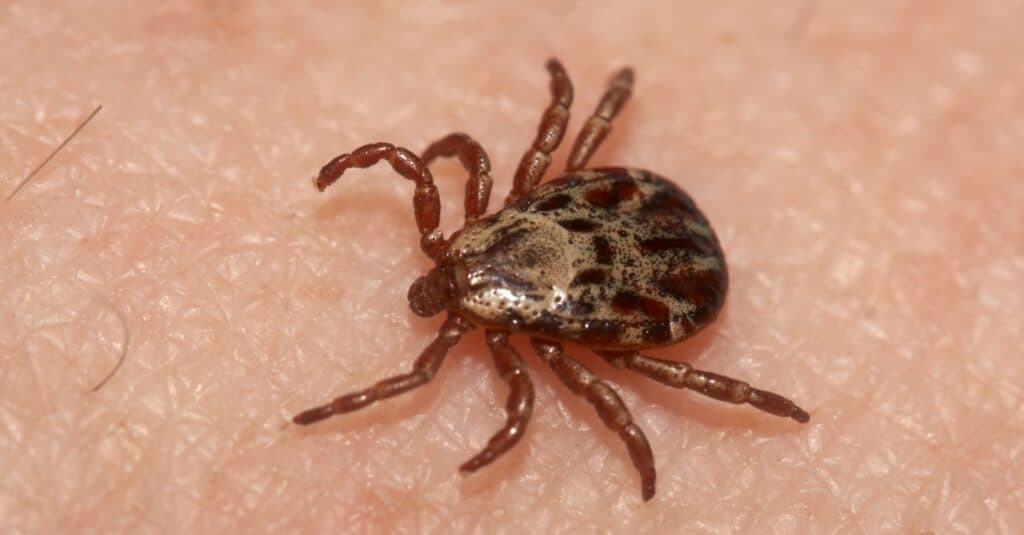
iStock.com/ironman100
The wood tick is a hard tick species that is between 2-6 mm long on average, and coloration differs between males and females. Male wood ticks have reddish-brown bodies with mottled grey and brown markings on the abdomen. Females lack this patterned mottling and are reddish-brown overall with a tan scutum. The wood tick is almost identical to the American Dog tick and identification depends on location. Wood ticks are also called Rocky Mountain Wood ticks because they are only found at elevations higher than 4,000 feet in North America. This species is the known vector of the Colorado Tick Fever virus.
Lone Star Tick

iStock.com/epantha
The Lone Star tick is 2-6 mm long in its adult life stage and has four life cycles. Lone Stars are reddish-brown over the entire body and only the female has the white star-shaped marking commonly associated with the species. As their name suggests, the Lone Star tick is most found in the Central United States and South America, though recently there have been sightings further north. Lone star ticks are not currently known to spread life-threatening diseases. However, there have been many reports of human bites causing severe and lifelong allergic reactions to red meat.
Gulf Coast Tick

iStock.com/cturtletrax
The Gulf Coast tick is also indistinguishable from the American Dog tick and the wood tick. Gulf Coast ticks are hard ticks with similar coloring and markings to both species and are also the same average size. Gulf Coast ticks are also identified primarily by location. They are found on the Northern Atlantic coast in the U.S. and in coastal locations on the Gulf Of Mexico. However, the Gulf Coast tick is on the move and has been recently spotted in new locations like Virginia and Kentucky. This species spreads another type of spotted fever virus like the wood tick and the American dog tick, as well as screwworm infections in cattle.
Additional Guides And Resources On Ticks
While this guide does not identify all nine hundred species of ticks, we have other resources available to help. Here at A-Z Animals, we have many articles on the most common tick species for many locations throughout the United States. This includes states like Montana and Colorado where the Wood tick is found and the deer tick danger zones like Maryland and Kentucky. Additionally, we have articles on ticks in extreme temperatures, like in Alaska and Arizona as well. We also offer key resources on where ticks live, what they look like, and insects that are often mistaken for ticks. And, since ticks are absolutely revolting, we can also tell you how to get them off your body, out of your house, and off your dog too!
More from A-Z Animals
.more-snake-card-image { max-height:140px !important; }
@media (min-width: 481px) {
.mobile-top-content {
display: none;
}
}
#mobileTopContentCTACarouselControls { overflow: hidden; text-overflow: ellipsis; white-space: nowrap; }
.mobile-top-content .more { color: #fff; }
.mobile-top-content a { color: #fff; text-decoration: underline; }
.mobile-top-content a:hover { color: #fff; text-decoration: underline; }
@media (max-width: 480px) {
.mobile-top-content {
background-color: #06a10b;
color: #fff;
text-align: center;
/*height: 60px;
padding-top:5px;*/
font-size:80%;
/* display: block; */
margin: 0px -30px;
}
}
The only thing worse than the idea of a tick is just how many species of them exist. Believe it or not, there are nine hundred known species of ticks found worldwide, and knowing this is enough to give anyone nightmares. But we absolutely must know how to identify them. While most ticks do not cause lasting harm, some of these parasitic bloodsuckers are vectors for deadly illnesses. While this guide cannot identify every single tick species individually, we can provide you with a comprehensive guide to identifying the two families that tick species fall under and a guide to identifying the most common ticks found in North America.
Additionally, this guide includes links to articles detailing the most common tick species found in each state of the U.S., as well as resources for how to deal with most tick-related issues!
Tick Types: Hard Ticks And Soft Ticks

iStock.com/ViniSouza128
All species of ticks are in the class of arachnids, identified by their eight legs in the same way as spiders and scorpions are. In total, there are nine hundred known species of ticks worldwide, and all are parasites that require blood to live. The tick genus is split into two families that each species falls into. These types are referred to as hard (Ixodidae) and soft (Argasidae) ticks. While identifying individual species can be difficult, knowing the difference between hard and soft tick species is easy.
Identifying A Hard Tick Species
There are seven hundred species classified as hard ticks, and they make up the bulk of known tick species. Hard ticks are identified by the hard, shield-like plate located behind the head called the scutum. Hard ticks also have visible mouthparts when viewed from above.
In most species the scutum is black. However, some hard tick species may have different scutum colors depending on whether the tick is male or female. For example, the female Lone Star tick has the signature white dot on the scutum, whereas the male does not. Males and females often have different colorations on the body as well. Additionally, female hard ticks are larger on average than males.
Diet, Life Cycle, And Habitat Of Hard Ticks
Hard ticks are most active during the day to search for a host in locations where larger vertebrate animals are present. They prefer moist wooded areas and grassy fields and are commonly found in overgrown brush or tall grass. Hard ticks have a 2-4 stage life cycle and live between 2-4 years, reproducing once in a life cycle.
Common Examples Of A Hard Tick Species
Common types of hard tick species in the U.S. are the wood tick, the deer tick, the American dog tick, and the lone star tick. Hard ticks are also the type most likely to encounter humans, as their preferred habitat is in open environments. Many of the tick species associated with dangerous illnesses are hard ticks, such as Lyme Disease and Rocky Mountain Spotted Fever. However, hard ticks are also easier to identify by species, which makes it easier to detect illnesses sooner.
Identifying A Soft Tick Species

Navid.drogba / Creative Commons – License
There are two hundred known species of soft ticks worldwide. While this is significantly less than the hard tick, it is still a high number. Soft ticks can be identified by their lack of a scutum and their wrinkled and rounder bodies. Additionally, soft ticks do not have visible mouthparts from above, as they are located on the underside of the ticks head. Female and male soft ticks are the same size and do not differ in coloration.
Diet, Life Cycle, And Habitat Of Soft Ticks
Soft ticks are active at night, seeking a host in the dens and burrows of animals, caves, or simple human dwellings in disrepair. Unlike hard ticks, soft ticks feed quickly and move on from a host. These types of ticks also thrive in hot and dry locations like the desert where hard ticks are less common.
Soft ticks go through multiple life cycles, including species that go through many nymph stages. Female soft ticks feed and produce eggs several times during their adult life cycle, producing between 20-40 at a time depending on feeding. Soft ticks can live for up to 16 years regardless of sex.
Soft Ticks And Disease
Humans encounter soft tick species due to rodent infestations in human dwellings. Since soft ticks are nocturnal feeders, bites occur most often while the host is sleeping. Also, as most human contact with tick species occurs with hard ticks, soft ticks are often mistaken for insects. Like hard ticks, most species are harmless apart from the bite, but some are not. Soft ticks are also dangerous because of their short feeding period. Soft ticks only feed for between 15 minutes to an hour and often the host has no idea they have been bitten. The most common illness caused by soft ticks is Tick-Borne Relapsing Fever or TBRF.
Common Examples Of Soft Ticks

Kellisfm / Creative Commons – License
The most common soft ticks that humans encounter in the United States are common fowl ticks and relapsing fever ticks. As the name suggests, the common fowl tick is found in poultry houses. Also referred to as the chicken tick or the blue bug, these ticks can spread illness to both poultry and humans.
The relapsing fever tick is as dangerous as the deer tick, though they are less likely to choose a human host. Fever ticks prefer small rodents but have been known to infect humans. They get their name from their ability to transmit relapsing fever, a potentially deadly disease. Fever ticks are infected for their entire lives and can transmit the disease multiple times.
A Complete Guide To The Most Common Types Of Ticks
Listing each of the nine hundred known species of ticks in the world would be impossible. However, knowing the difference between a hard tick and a soft tick goes a long way. However, while most species of ticks do not carry diseases to humans, some species are quite dangerous. The most common species of ticks we encounter are the most likely to make us ill, so identification is key. Therefore, this is the complete guide to the most found ticks in the United States.
Dog Tick
The most common type of tick most humans encounter is the dog tick. There are two species, the American and the brown dog tick. Their common name refers to their fondness for choosing mammals like domesticated dogs as a host. However, dog ticks will attach to most small or midsized animals and even relocate to a human if the opportunity is there. Dog ticks are classified as hard ticks, and their appearance varies depending on the species. While American dog ticks are slightly larger than brown dog ticks, when engorged they are identical.
American Dog Tick

Elliotte Rusty Harold/Shutterstock.com
The American dog tick has a rounded abdomen and is a reddish-brown color with beige markings. On the female tick, the scutum is the only location with these beige markings. In the nymph stage, these ticks have the same markings and look like a paler version of their adult form. American dog ticks prefer to live their lives outdoors to breed. The American dog tick is also known to transmit Rocky Mountain Spotted Fever.
Brown Dog Tick

iStock.com/RobertAx
Brown dog ticks have a narrow, oval body that is a medium brown color overall. Both males and females are the same brown color, and nymphs are paler brown. Unlike the American dog tick, the brown dog tick can live its entire life cycle indoors, burrowing into carpets and the fur of house pets. Unlike many other ticks, brown ticks may feed on the same host for different life stages. Brown dog ticks rarely move to a human, preferring dogs to any other host. Check out the article linked here for more on the Brown dog tick.
Deer Tick

Kaldari / Creative Commons – License
Deer ticks are one of the smaller hard tick species, the size of a sesame seed at the adult life stage. This species has four life cycles, and a nymph or seed deer tick is particularly difficult to see. Deer ticks can be identified by their reddish-brown bodies and their black legs, the source of the alternate name of the black-legged tick. This is one of the more dangerous tick species, and the deer tick is the vector of Lyme Disease. The deer tick is most found throughout the Eastern and Midwestern United States.
Wood Tick

iStock.com/ironman100
The wood tick is a hard tick species that is between 2-6 mm long on average, and coloration differs between males and females. Male wood ticks have reddish-brown bodies with mottled grey and brown markings on the abdomen. Females lack this patterned mottling and are reddish-brown overall with a tan scutum. The wood tick is almost identical to the American Dog tick and identification depends on location. Wood ticks are also called Rocky Mountain Wood ticks because they are only found at elevations higher than 4,000 feet in North America. This species is the known vector of the Colorado Tick Fever virus.
Lone Star Tick

iStock.com/epantha
The Lone Star tick is 2-6 mm long in its adult life stage and has four life cycles. Lone Stars are reddish-brown over the entire body and only the female has the white star-shaped marking commonly associated with the species. As their name suggests, the Lone Star tick is most found in the Central United States and South America, though recently there have been sightings further north. Lone star ticks are not currently known to spread life-threatening diseases. However, there have been many reports of human bites causing severe and lifelong allergic reactions to red meat.
Gulf Coast Tick

iStock.com/cturtletrax
The Gulf Coast tick is also indistinguishable from the American Dog tick and the wood tick. Gulf Coast ticks are hard ticks with similar coloring and markings to both species and are also the same average size. Gulf Coast ticks are also identified primarily by location. They are found on the Northern Atlantic coast in the U.S. and in coastal locations on the Gulf Of Mexico. However, the Gulf Coast tick is on the move and has been recently spotted in new locations like Virginia and Kentucky. This species spreads another type of spotted fever virus like the wood tick and the American dog tick, as well as screwworm infections in cattle.
Additional Guides And Resources On Ticks
While this guide does not identify all nine hundred species of ticks, we have other resources available to help. Here at A-Z Animals, we have many articles on the most common tick species for many locations throughout the United States. This includes states like Montana and Colorado where the Wood tick is found and the deer tick danger zones like Maryland and Kentucky. Additionally, we have articles on ticks in extreme temperatures, like in Alaska and Arizona as well. We also offer key resources on where ticks live, what they look like, and insects that are often mistaken for ticks. And, since ticks are absolutely revolting, we can also tell you how to get them off your body, out of your house, and off your dog too!

